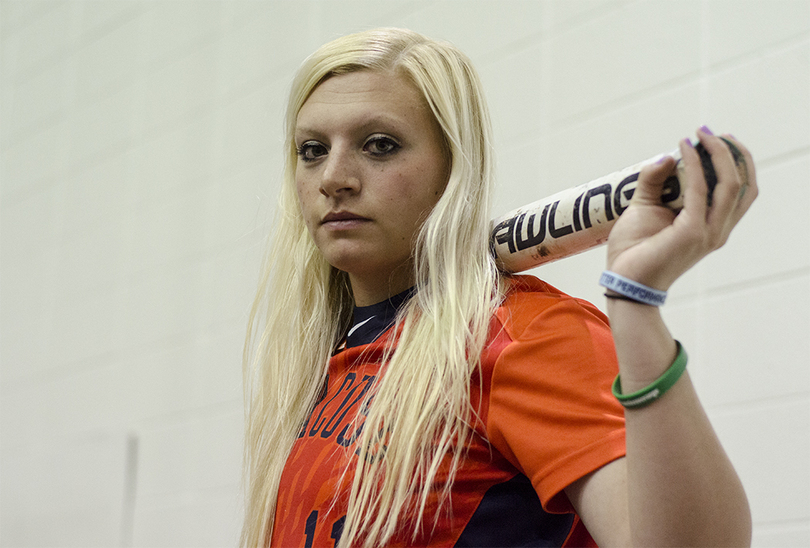Sydney O’Hara’s 66-mph rise ball and abnormal bat speed propelled her to the top of the SU record books

Sydney O'Hara was named a finalist for national player of the year, ranking first in batting average (.480) and on-base percentage (.629). She also ranks second in the nation with six saves and 12.6 strikeouts per seven innings pitched. Ally Moreo | Photo Editor
Sydney O’Hara had accepted the deal. She would fulfill her lifelong dream of playing softball at Syracuse, but as an outfielder and not in the pitcher’s circle. Despite 741 career strikeouts in high school, the SU coaching staff doubted O’Hara had the movement and control to pitch in Division I. Then, former Syracuse head coach Leigh Ross witnessed something that changed her mind.
In a spring 2013 scrimmage against Saint Dominic (New Jersey) Academy at Manley Field House, O’Hara, a Cicero-North Syracuse (New York) High School senior, dominated for five innings. As Ross watched from behind the backstop, O’Hara pinpointed pitches up and down the plate and spun the ball side to side. The scrimmage ended and O’Hara wasn’t just a hitter anymore.
“At that point, she knew she had nothing to lose,” said Kim Aupperle, O’Hara’s childhood pitching coach. “… So, when she got the opportunity to pitch, she had that sense of, ‘I have nothing to lose I am just going to throw the sh*t out of the ball.’”
One year later, O’Hara threw a no-hitter in her first career start at Syracuse and has since averaged more than one strikeout for every inning she’s pitched. But the now-senior has also made good on the promise Ross once saw in her. The first baseman and pitcher is a national player of the year finalist and ranks first in two national categories: batting average (.480) and on base percentage (.629). She ranks second in saves (six). O’Hara enters her final ACC tournament having already overcome injury and expectation. But for O’Hara, the individual success simply won’t be enough.
“She gets off on being the best,” said Kerry Bennett, her high school coach.
Though O’Hara has blossomed into a DI pitcher, she at first got looks only for her prowess at the plate. O’Hara, who tied the NCAA record with four home runs in a single game against North Carolina State on March 10, wasn’t always a power hitter. She couldn’t be, as her ambition usually exceeded her ability.
The summer before eighth grade, O’Hara hung around the Gillette Road Softball Complex in Cicero, New York. On Mondays, she played in her age group. On Tuesdays and Wednesdays, the 13-year-old perused the field, looking to fill in for teams with players up to 18 years old wherever someone needed an extra player. But on Thursdays, O’Hara took her biggest jump.
She played second base and right field for teams in the 23-and-under league that needed the extra bat. She didn’t swing away against competition nearly twice her age, so she turned to slap-hitting. She refined the technique as an eight-year-old when she was a self-described “tiny little thing.”
At the direction of Bennett, who eventually coached O’Hara for four years at Cicero-North Syracuse, O’Hara switched from batting on her natural right side to the left side of the plate to slap hit. Bennett assured O’Hara and her father, Jim O’Hara, that the switch would be beneficial. Whether O’Hara stayed small and speedy or stopped slapping all together, coaches love lefty hitters.
“I like to challenge myself,” O’Hara said. “Obviously, I would get really frustrated if I struck out or bobbled a ball in the infield. … But my parents kept me sane and said, ‘Well, you are playing against college girls, don’t beat yourself up over it.’”
***

Ally Moreo | Photo Editor
As she sought better competition, O’Hara looked for ways to get better herself. Aupperle introduced the seventh grader to “the spinner,” a tool usually used by high school pitchers to increase crucial movement on pitches.
“I handed it to her and said, ‘You are not going to like this until you really understand it,’” Aupperle recalled.
The hockey puck-like disk has two laces on it, matching those on a softball, and its visible rotation makes movement easier to track. When throwing a curve, the disk should spin flat like a pancake. With a riser, it should spin vertically end over end. If the spinner wobbles, the pitcher’s fingers are too rigid, Aupperle said, and she needs a looser grip.
The spinner gatewayed to the curveball and rise ball in O’Hara’s arsenal. She made one of her first pitching appearances for C-NS while she played varsity as an eighth grader. Bennett took O’Hara out of her standard spot in the outfield to save his more valuable arms for the looming playoff run. O’Hara doesn’t remember how many runs she let up at Liverpool that day, but she remembers getting “hit around pretty well.” She wasn’t ready yet. She hadn’t mastered the spinner.
“The better her spinner got the better her pitches got.” Aupperle said. “It was almost like an addiction. The better her spins would get, the flatter the spinner looked, the more she wanted to keep doing it.”
In the meantime, O’Hara provided value by knocking around other pitchers herself. She hit her first of 25 career homeruns for Cicero-North Syracuse in a game she wasn’t supposed to play in. Bennett originally told the freshman she wouldn’t be playing against Henninger (New York) High School. But no run production arrived from his starters, so Bennett summoned O’Hara from the bench. That day, she didn’t slap hit as she usually did. The lefty swung away and batted in all four runs for C-NS, including her first home run, in a 4-0 victory.
“The thing that was most noticeable when she was younger … was the sound of the bat hitting the ball was a lot louder than the others,” Bennett said. “She gets everything together on a swing and maximizes the bat speed. You don’t have to see it, you can hear it.”
The sound comes as a product of O’Hara’s tireless work with her father at Gillette. It’s a place that, if the fields are locked, the two call a little league coach and soon they become available. The O’Hara’s four-day-per-week routine begins with swings off the tee and progresses to Jim soft-tossing from 10 feet away. There, over the years, O’Hara has practiced throwing her hands fully through the zone against outside pitches and learned to either take the pitch opposite field or foul it off in hopes of a better pitch to hit.
O’Hara needed those lessons, particularly entering her senior year of high school. C-NS had fallen in the state championship game three years in a row. After her junior year, C-NS fired Bennett after an alleged bullying scandal. Prior to the season, O’Hara, a senior captain, met with new head coach Mary Beebe. She told Beebe the team had unfinished business, and she wasn’t going to leave high school without winning the state title.
The first baseman and pitcher was now best equipped to deliver on that promise. Though she rolled her eyes at each training session with Aupperle as she broke out the spinner, it had helped O’Hara finally break through into a starting role in the circle. She had won central New York Player of the Year her sophomore and junior years, but she never won the team award she wanted most.
To bring the team closer than it had been in years past, O’Hara organized team bonding events such as pasta dinners throughout the season prior to games. She sat down with Beebe four or five more times during the season to make sure things were going according to plan.
Her final season with C-NS ended the way the previous three hadn’t. O’Hara struck out 12 batters in seven innings and hit two homeruns to beat East Meadow (New York) High School and win the state title.
***

Ally Moreo | Photo Editor
As a freshman at Syracuse, O’Hara posted a 3.83 earned run average and hit .333 before hitting a road block in her sophomore season. At first, she told the coaching staff her arm was just getting tired and needed rest. But the soreness in her throwing elbow worsened with each outing and her right hand swelled up like a balloon midway through the season. O’Hara thought she had a blood clot, but the sonogram came back negative. Doctors diagnosed her with an MCL tear in her right elbow.
She was shut down for nearly a month in 2015, but even upon her return against North Carolina, the sophomore struggled to find her old success. She allowed 13 runs in her final 5.1 innings pitched of the 2015 season.
Over the next six months, O’Hara wasn’t allowed to pitch or workout her upper body. Her exercise was limited to running for the summer leading into her junior year.
O’Hara’s inability to train in the offseason showed on the field. She posted her worst batting average, .272, in a single season at SU and only managed to throw 62 innings in the entire season with her arm still limited by the injury.
“She set her mind to it mentally that was she going to leave Syracuse on a high note,” Jim said. “She told me that before the summer (after junior year), because she was a little disappointed.”
Syracuse strength and conditioning coach Will Hicks pushed O’Hara into the best shape of her life, she said, headed into her final season. The utility player spent all but three or four days the entire summer at Manley Field House training with Hicks. Over Thanksgiving break, she completed “workout bingo,” choosing five workouts in a row off a board — including gasser sprints, ab workouts, and stair master routines, among others — to spell out “bingo.” During winter break, O’Hara completed all 25 workouts, blacking out the board and earning a deduction of one gasser off her conditioning test as a reward.
The workouts prepared O’Hara for a historic season. She set a program record for career saves (11) as she compiled more strikeouts this year, 125, than in her last two seasons combined. In the week following her four-home run game, she became the first Syracuse athlete to win ESPNW player of the week, while also having her highlights featured on SportsCenter’s Top 10.
“The game knows what you do,” Bosch said. “I think the game is giving back to her this year for all the time she’s put in over her years here and even before her time here.”
***

Ally Moreo | Photo Editor
The player who wasn’t supposed to pitch at Syracuse was reluctant to reflect on her SU career before it ends. When her father mentioned the looming final home game of O’Hara’s career, his daughter quickly noted her focus is on the Atlantic Coast Conference tournament and not the end of her career. It’s the way O’Hara has always been.
Now, the girl from Cicero-North Syracuse can’t help herself but peek back. She maintained numbers that she said don’t mean much to her, but that represent one of the most impressive stat lines in program history. And all she wanted to do was be here.
“(It was always about) just being local and showing my teammates and younger girls that anything is possible,” O’Hara said, tears leaking from the corners of her eyes. “Whatever you work toward and put your mind to, it will happen.”




